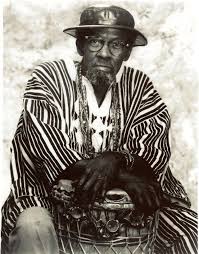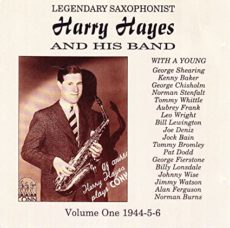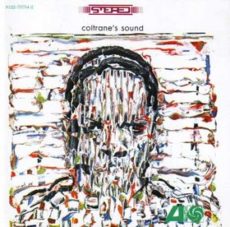
Three Wishes
Chief Bey told Baroness de Koenigswarter his three wishes were:
-
-
“To live in a world of complete freedom, where man does not lose his creative ability and his senses, and where his respect for the next man broadens by the day. And that the ultimate end of all his troubles, trials and tribulations would turn out to be for the good of every man. And that it will be a perpetuating thing, like the evergreen tree.”
-
“That man should always worship in that which he believes, and live what he believes to such an extent that it shows in his every action. And then he does not have to preach it to the world, that I am.”
-
“My third and final wish: that there be no hunger. A little pain, a little suffering ~ enough to make one understand himself. So that I, as one of God’s creatures, that every time I perform, may it be for Him. And let me re-create again and yet again without repeating myself. And when I play, for dancers to dance to my drums. May there always be communication.”
-
*Excerpt from Three Wishes: An Intimate Look at Jazz Greats ~ Compiled and Photographed by Pannonica de Koenigswarter
More Posts: baroness,history,instrumental,jazz,music,pannonica,percussion,three,wishes

Daily Dose Of Jazz…
David Burns was born on March 24, 1924 in Perth Amboy, New Jersey and began playing trumpet when he was nine years old. As a teenager, he heard bebop performances at Minton’s Playhouse, among others Dizzy Gillespie. His first ensemble was in Al Cooper’s Savoy Sultans, with whom he played from 1941 to 1943, prior to joining the Army Air Force. There he led a band from 1943 to 1945 that included James Moody as a sideman.
He joined Gillespie’s band in 1946 and appeared with Gillespie in Jivin’ in Bebop in 1947. After leaving Gillespie’s band in 1949, he worked with Duke Ellington from 1950 to 1952 and then with James Moody until 1957.
The late 1950s saw Dave playing shows in New York City and in the Sixties recorded for Vanguard Records. He worked with Billy Mitchell, Al Grey, Willie Bobo, Art Taylor, Dexter Gordon, Johnny Griffin, Leo Parker, and Milt Jackson. From the 1970s through the end of his career he increased his work as an educator. Trumpeter, flugelhornist, arranger, composer, and teacher Dave Burns passed away on April 5, 2009 in Freeport, New York.
More Posts: arranger,composer,educator,flugelhorn,history,instrumental,jazz,music,trumpet

Daily Dose Of Jazz…
Harry Hayes was born Henry Richard Hayes in Marylebone in the West End of London, England on March 23, 1909, a bookmaker’s son. Winning a scholarship to his local grammar school, he was given a soprano saxophone by his father when he was 11 and by age 16, made his professional debut as an alto player at the Regent dance hall in Brighton. He was soon playing at London’s Kit Kat Club and the Piccadilly hotel. In 1927, he joined Elizalde at the Savoy, working alongside Americans like saxophonists Adrian Rollini, Fud Livingstone and Bobby Davis, trumpeter Chelsea Quealey, and pianist Jack Russin.
He became highly successful during the big band era of popular music that dominated by radio and bands playing London hotels and clubs. The late 1920s through the 30s, Hayes worked with musicians and bands such as Sydney Kyte at Ciro’s Club, pianist Billy Mason at the Cafe de Paris, Spike Hughes’s Orchestra at the Empress Rooms, Leslie “Hutch” Hutchinson, and Maurice Winnick at the Carlton, with Harry Roy at the Mayfair and with Sydney Lipton at the Grosvenor House. In 1932, he was featured in the band that accompanied Louis Armstrong’s first British tour.
Called up in 1940, Hayes served in the Welsh Guards band but continued to perform with others. After his discharge in 1944, he formed an eight-piece band, which went on to record sessions for HMV at Abbey Road featuring some of the best players of the day including Harry Roche, Norman Stenfalt, a young George Shearing and tenor saxophone Tommy Whittle. He played with Benny Carter, and appeared in a London Jazz At The Philharmonic concert with Oscar Peterson, Ella Fitzgerald, and Lester Young.
By 1947, Hayes was playing Charlie Parker bebop, and opening his first music shop in Shaftesbury Avenue. He was also active as a music teacher. While working with Kenny Baker in the 1950s, he led his own band at various London nightspots. Retiring from regular playing in 1965, he continued to run his shops until 1985. He was granted the freedom of the City of London in 1988 nd his last performance was at the Birmingham international jazz festival in 1992. Saxophonist and shopkeeper Harry Hayes passed away at the age of 92 on March 17, 2002.
More Posts: bandleader,history,instrumental,jazz,music,saxophone,shopkeeper

Requisites
Coltrane’s Sound is an album credited to jazz musician John Coltrane, released in 1964 on Atlantic Records, catalog SD 1419. It was recorded at Atlantic Studios during the sessions for My Favorite Things, assembled after Coltrane had stopped recording for the label and was under contract to Impulse! Records. Like Prestige and Blue Note Records before them, as Coltrane’s fame grew during the 1960s Atlantic used unissued recordings, releasing them without either Coltrane’s input or approval.
Track Listing | 38:18 ~ Original Recording / 50:33 CD Reissue *All compositions are by John Coltrane except where mentioned
- The Night Has A Thousand Eyes ~ Buddy Bernier, Jerry Brainin ~ 6:51
- Central Park West ~ 4:16
- Liberia ~ 6:53
- Body and Soul ~ Edward Heyman, Robert Sour, Frank Eyton, Johnny Green ~ 5:40
- Equinox ~ 8:39
- Satellite ~ 5:59
- John Coltrane ~ tenor saxophone except for soprano Central Park West
- McCoy Tyner ~ piano
- Steve Davis ~ bass
- Elvin Jones ~ drums
- Nesuhi Ertegün ~ production
- Tom Dowd ~ engineering
- Marvin Israel ~ photography
- Ralph J. Gleason ~ liner notes
Fans of Modern Jazz know that John William Coltrane was in a league of his own as a bandleader, composer, soprano and tenor saxophonist, making some of his most substantial contributions to the music genre recording for Atlantic, Impulse and Prestige. The album up for discussion is Coltrane’s Sound (Atlantic 1419), originally recorded in 1960 at the same session that also gave the jazz world, My Favorite Things. This album was released in 1964, three years into Coltrane’s contract with Impulse Records, capitalizing on his increasing popularity during the first half of the sixties. Though criminally underrated, it’s an outstanding program of two timeless evergreens and four original tunes that Coltrane demonstrates are just as enjoyable as the standards. This album in my opinion also helps solidify his place as one of the most important musicians of the twentieth century. Completing the quartet are McCoy Tyner on piano, Steve Davis on bass and Elvin Jones on drums. My copy used in this report is the 2010 Rhino Records US Stereo Audiophile Reissue (SD 1419–R1 1419).
Side One opens with a sparkling rendition of The Night Has a Thousand Eyes, written in 1948 by Jerry Brainin and Buddy Bernier. This jazz and pop standard made its introduction in the film noir crime drama Night Has a Thousand Eyes, released that year. The movie was based on the 1945 novel by author Cornell Woolrich. The song is one of the most popular standards in The Great American Songbook and has been recorded numerous times as a vocal and instrumental. Sometimes played and sung sublimely, the quartet offers a lively theme treatment that’s inspiring. John starts the soloing charging out the gate with a vigorous performance. McCoy heats up the closing reading with exuberant enthusiasm into the coda. Trane turns to the soprano sax for Central Park West, the first of four tunes by the leader. It opens with an alluring introduction and ends with an equally tender melody led by John who also expresses gentle feelings on the opening statement with a soft timbre. The song’s final solo by McCoy is an intimately polite presentation anchored by the affectionate infrastructure of Steve and Elvin.
The first side wraps up with Coltrane’s Liberia, returning the foursome to an uptempo beat with a sprightly theme treatment in unison. John takes the opening statement, gradually building each verse efficiently into a passionate climax. Tyner displays his strong chops on a short closing solo that’s stunning into Trane’s reappearance for the finale. The ageless classic Body and Soul begins the second side with a midtempo rendition by the quartet. It was written in 1930 by Frank Eyton, Johnny Green, Edward Heyman, Robert Sour. The most famous instrumental version was made in 1939 by Coleman Hawkins for Bluebird and it’s one of the most recorded standards in the history of music. The trio led by McCoy’s cheerful piano introduces this chestnut and John provides a succulent treat of what’s in store on the opening melody and heightens the mood on the lead solo. McCoy flavors the next reading with a joyful swing to the infectious beat, then Coltrane makes a final statement that’s brief, but clever leading to the blissful conclusion.
Up next is Equinox, a slow tempo blues by John that was named by his first wife, Naima. The equinox occurs twice a year, the first one around March 21st and the second by September 23rd. It’s the point when the sun crosses the equator with day and night, everywhere on earth approximately at an equal length. The rhythm section opens the song sensuously into Trane’s elegantly tender opening chorus and passionate solo. Tyner concludes the readings with a delicately gentle performance over the soothing support of Davis’ bass and Jones’ elegant timekeeping. Coltrane’s Satellite, the album finale is a trio performance following in the footsteps of Sonny Rollins’ trio LP’s with just the bass and drums providing the power behind him. This tune is a jubilant joyride with John blowing fire on the theme and excitingly fierce solo. Steve dazzles with feisty exuberance and Elvin brings the heat with aggressive brushwork behind John’s reprising the theme into the climax.
The man behind the dials of the original recording was one of the best engineers in the business, Tom Dowd and Nesuhi Ertegün supervised the album’s production. Bernie Grundman cut the lacquers from the original analog masters, utilizing premium 180-gram audiophile vinyl by RTI (Record Technology Incorporated). The sound quality of Mr. Dowd’s work has been beautifully remastered and is amazing throughout the treble, midrange and bass spectrum with a very revealing soundstage for the instruments placing the listener’s favorite chair in the center of the studio alongside the musicians. If you’re in the mood for an album of Hard-Bop and Modal Jazz, I invite you to audition Coltrane’s Sound by John Coltrane. It’s a great LP that makes a profound statement to a legendary jazz giant and a title that should not only appease and delight the serious jazz aficionado but the first-time listener as well! See you next month and Happy Listening Gang!
~ Body and Soul (Bluebird B-10523-A); My Favorite Things (Atlantic 1361/SD 1361) – Source: Discogs.com
~ The Night Has a Thousand Eyes, Body and Soul – Source: JazzStandards.com
~ Equinox – Source: The Merriam-Webster Unabridged Dictionary, Wikipedia.org
More Posts: choice,classic,collectible,collector,history,instrumental,jazz,music,saxophone

Daily Dose Of Jazz…
Sonny Burke, born Joseph Francis Burke on March 22, 1914 in Scranton, Pennsylvania and in the Thirties attended Duke University where he formed and led the jazz big band called The Duke Ambassadors. Graduating in 1937, during the 1930s and 1940s, he was a big band arranger in New York City, working with Sam Donahue’s band.
In the 1940s and 1950s, he worked as an arranger for the Charlie Spivak and Jimmy Dorsey bands, among others. 1955 saw him writing, along with Peggy Lee, the songs to Disney’s Lady and the Tramp. He also wrote songs with John Elliot for Disney’s Toot, Whistle, Plunk and Boom, which won the 1953 Oscar for Best Short Animated Feature.
Burke wrote the music for number of popular songs that continue to be regarded as jazz standards including Black Coffee, with lyric by Paul Francis Webster, and Midnight Sun, co-written with jazz vibraphonist Lionel Hampton. An active arranger, conductor and A&R man at major Hollywood record labels, especially Decca Records, he worked with Charles “Bud” Dant. He also wrote and arranged the theme for the early 1960s television show Hennesey, a jazzy update of the Sailor’s Hornpipe.
Later Sonny went on to become musical director at Warner Bros./Reprise Records. He was responsible for many of Frank Sinatra’s albums and produced Sinatra’s iconic recording of My Way and Petula Clark’s classic This Is My Song written by Charles Chaplin for his movie A Countess From Hong Kong. He was also the bandleader for recordings of leading singers such as Dinah Shore, Bing Crosby, The Andrews Sisters, The Mills Brothers, Ella Fitzgerald, and Mel Tormé.
Arranger, composer, big band leader, and producer Sonny Burke passed away from cancer on May 31, 1980 in Santa Monica, California at the age of 66.
More Posts: arranger,big band leader,composer,history,instrumental,jazz,music,producer



